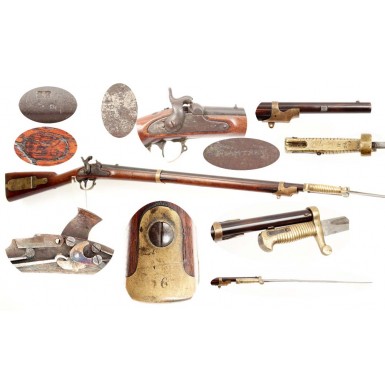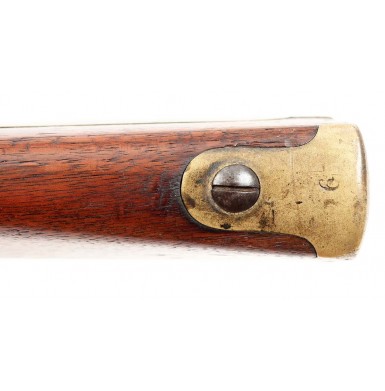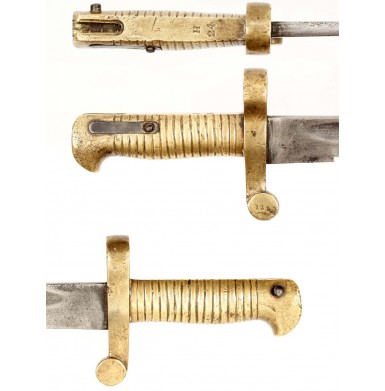Confederate Altered Mississippi Rifle & Saber Bayonet
- Product Code: FLA-2163-SOLD
- Availability: Out Of Stock
-
$1.00
At the beginning of the American Civil War nearly 20,000 US M-1841 “Mississippi” rifles were in the arsenals within the states that had seceded to form the Confederacy. Some 9,304 had been issued to these southern states under the Militia Act of 1808, between the years of 1845 and 1859. In general, these guns were manufactured by the 4 primary M-1841 rifle contractors: Tryon, Remington, Robbins & Lawrence and Whitney. Based upon numbers manufactured, period documents and surviving examples, it appears that the majority of the M-1841 rifles in southern arsenals prior to 1859 were manufactured by Eli Whitney Jr., with the guns produced by Robbins & Lawrence being the second most numerous examples. (See “Distribution of Arms to the Militia Under the Act of 1808, National Archives Record Group #156, Entry #118) Those 9,304 guns were sent Virginia, North Carolina, South Carolina, Mississippi and Texas, with only 1,411 being Harpers Ferry produced M-1841 that had been modified with long range sights and bayonet lugs. (see Murphy & Madaus Confederate Rifles & Muskets section XXIV). An additional 10,000 M-1841 rifles were sent to southern states on December 30, 1859 by Secretary of War John B Floyd. Floyd sent the rifles to the south for state militia use, as a reaction to the John Brown raid on Harpers Ferry. He was also motivated by strong southern sympathies, a general belief that war was probably on the horizon, and the arms would be sorely needed in the south. In general the M-1841 Mississippi rifles in the southern arsenals on the eve of the American Civil War were in their original .54 caliber configuration, without any modifications to their sights or caliber, or any facility to mount a bayonet. With the start of the war, many of these unaltered US M-1841 Mississippi Rifles were modified in southern arsenals and by southern gunsmiths to accept bayonets, which were typically of the saber variety. While some of the alternations have been specifically attributed to Confederate gunsmiths like J. H. Happoldt of Charleston, SC, the majority of the remain unidentified, and are often simply referred to as “Virginia” alterations of US M-1841 Mississippi Rifles, as most saw use in the Virginia theatre of operations. Of the 19,304 Mississippi Rifles in southern hands at the beginning of the war, 17,893 were .54 caliber without any means of mounting a bayonet. The solution for many of these guns was to braze a saber bayonet lug to the right side of the barrel, typically between 3” and 3 ““ from the muzzle. While the majority of these lugs were simple affairs, about ““ long without any “key” or “guide”, a handful were altered with a key or guide forward of the lug. Invariably, the saber bayonets provided for use with the newly altered rifles were simple copies of the US M-1855 saber bayonet with cast brass hilts and steel blades. The majority of the bayonets were not maker marked, but numerous well-known southern makers delivered saber bayonets on contract, including Cook & Brother, Boyle & Gamble, Burger & Brothers, Louis Froelich, etc. Who performed the alterations of these rifles remains somewhat mysterious, as research into the Confederate Citizen Files (US Archives Record Group 109) has revealed only a handful of gunsmiths and gunmakers who were altering US M-1841 rifles to accept saber bayonets. Among these were J. H. Happoldt of Charleston, SC, who altered at least 353 rifles, and William B & Cyrus Fisher of Lynchburg, VA who “repaired” 65 rifles for “Captain George Field’s Company” in July of 1861. Such alterations were likely performed by other southern gunsmiths in Virginia, North Carolina, South Carolina and even Tennessee. As noted above, the alterations typically revolved around the addition of a saber bayonet lug to the right side of the barrel. However, this created a problem, in that the upper barrel band could not be removed after the lug was added to the barrel. The solution adopted at Harpers Ferry was the adoption of a new, shorter barrel band that could be removed from the stock and rotated 90”, allowing it to clear the lug. The southern gunsmiths did not have the time, budget, or often the ability to cast new upper bands for the rifles they altered. Their solutions had to use the parts already available on the gun, with minimal fabrication. The Happoldt solution was to make a pair of cuts in the bottom lip of the barrel band that removed enough brass to allow the band to be slipped forward, rotated 90”, and removed over the lug. This was a clean and simple alteration, but required a level of skill in altering the barrel band. Most of the other, “unidentified” Confederate alterations involved cutting away the forward upper strap of the band, allowing it to pass over the applied lug. In some cases, the band was shortened as well. These “cut away band” alterations are the guns that are so generically referred to as “Virginia Alterations’ by collectors.
This particular “Virginia Altered” US M-1841 Rifle is in about GOOD+ to NEAR VERY GOOD condition. It is a classic example of a Confederate altered Mississippi rifle, with a cut away upper barrel band, applied saber bayonet lug, but with no modifications to the sighting system or caliber. The gun retains its original .54 caliber bore with 7-groove rifling and its original fixed sights. As is so common with these guns, there are practically no external marks that provide any clues as where or by whom the gun was altered. However, one external clue does exist that might one-day help to identify the gunsmith who worked on the gun. The top of the buttplate is stamped with the number 6, near the toe of the stock. A Mississippi Rifle with the same type of bayonet lug and altered front barrel band is depicted in Murphy & Madaus’s Confederate Rifles & Muskets in plate 12 and 13 of Section XXIV, and is described on pages 352-354. The example pictured (from the Charles L. Foster Collection) is marked with the number 45 near the toe of the stock. The gun shows another Confederate trait that is less obvious, and is most visible once the lock is removed. The tumbler appears to have been replaced during the period of use and is rather crude. It’s fit to the hammer is not very good, and the hammer has thin metal shims to improve its fit on the tumbler. The tumbler has a very crude, very low “half-cock” position, which is much lover than typical US arms. The inside of the lock is marked with seven crude and cryptic “punch dots’ in a line along the reinforced upper edge. It appears that the similar punch does were also applied to the interior of the hammer neck, but due to oxidation and wear they are barely visible. This method of marking the interior of a lock is found on some of the “Mississippi Style” North Carolina Rifles delivered by Gillam & Miller of Jamestown, NC. An example of Gillam & Miller rifle #144 is shown on page 274 of Confederate Rifles & Muskets, with 4 cryptic punch dots inside the lock in the same location as the ones found in this rifle. This suggests that Gillam & Miller (or another North Carolina gunmaker) may have affected the repairs on this rifle, and may well have installed the saber bayonet lug and altered the upper barrel band as well. Other than the cryptic internal marks, the 6 on the buttplate and the bayonet lug / band alteration, the gun is essentially a standard Eli Whitney Jr. produced M-1841 Mississippi Rifle. The lock is marked simply E. WHITNEY in a single line, forward of the hammer, and N. HAVEN / 1850 in two vertical lines behind the hammer. The date on the barrel tang is not legible due to flash pitting and erosion, but the typical Whitney US / S.K. / VP barrel proofs are still visible, although the “US’ is rather weak. The word STEEL on the left barrel flat is very weak, and only visible under high magnification. A single, barely legible, script cartouche (possibly “JH”), is present on the flat opposite the lock. As is so common on CS used M-1841 rifles, it appears that initials were scratched into the brass side plate, but they are no longer legible. The gun has a mostly smooth, lightly oxidized brown patina over all of the metal surfaces, mixed with some strong traces of original brown finish. There is some lightly scattered peppering and pinpricking along the barrel, forward of the rear sight, along with some lightly oxidized freckled surface roughness. To the rear of the sight and in the breech area there is light to moderate pitting from firing and percussion cap flash. The bore of the altered rifle rates about GOOD+ to NEAR VERY GOOD. It is partly bright with patches that are dark and dirty, and shows light to moderate pitting along its entire length. The rifling of the bore is very strong and the rifle remains in its original .54 caliber. The lock of the rifle is in about GOOD mechanical condition. As mentioned, the hammer is fit to a poorly made period tumbler, and this results in some perceived looseness in the fit between the two pieces. The tumbler has a very low half-cock, that is almost imperceptible, and initially I thought there was no half-cock at all. The hammer locks into the full-cock position as it should, but the entire feel of the lock is somewhat spongy and not very crisp. The brass furniture has a deep, dark, untouched patina. The interior of the patchbox has a wonderful build up of thick green verdigris. The rifle retains its original fixed rear sight, and the original brass blade front sight, which shows some wear. The gun retains its original Confederate applied saber bayonet lug, which is .53” long and has no key. It is brazed directly to the barrel. No dovetail was cut for the bayonet lug. The lug is mounted 3 3/8” from the muzzle. The rifle is missing its ramrod and both of its sling swivels. Interestingly, the CS altered Mississippi rifle noted in Murphy & Madaus with the same type of numerical buttplate marking is missing both swivels as well. As an added bonus, the rifle is accompanied by an original, Confederate made, saber bayonet that fits it perfectly. The Confederate made brass handled saber bayonet is essentially a crudely made copy of the US M-1855 saber bayonet. The bayonet is unmarked, with the exception of the number 121 stamped into the obverse finial at the bottom of the cross guard, and the alphanumeric mark H / 24 stamped into the top of the hilt. The bayonet is 24 3/8” in overall length, with a 4 5/8” long cast brass hilt and a 19 ““ semi-Yataghan blade. The blade is 1 ““ wide at the ricasso, and has a 14” fuller. The brass hilt is somewhat crudely cast and is roughly finished. The muzzle ring is slightly irregular, but mates with the rifle perfectly. The ring has a .883” muzzle diameter. The top of the hilt has a 1” mortise cut into it, which is roughly finished. The rear of the pommel has a flat profile, similar to the pommel caps of Boyle & Gamble bayonets, but without the exaggerated birds head pommel shape. The original locking mechanism is in place in the hilt and remains fully functional. The blade has a medium gray patina, with scattered salt and pepper, oxidized discoloration scattered along the entire length of the blade. The blade shows a couple of significant flaws, which is quite common on Confederate manufactured bayonets. The there is some light pinprick pitting scattered along the blade, with the most noticeable patches being near the tip of the bayonet. The stock of the altered rifle is in about GOOD+ to NEAR VERY GOOD condition. The stock remains fairly crisp with decent edges and shows no signs of having been sanded. The stock is solid, but does show some cracks and one small repair. There is a short crack along the top of the stock, next to the barrel tang, which is clearly visible in the pictures. This is probably from improper barrel removal. There is also a very short grain crack running from the rear lock screw to the barrel channel. This is a typical stress crack that happens when the lock screws are over tightened. It is tight and solid and should present no problems. There is a tiny piece of wood that has been repaired at the lower rear of the lock mortise. This is about the size of a small fingernail and is barely noticeable. The rifle shows significant burn out and wood loss between the hammer and bolster, which is typical of percussion arms that have seen significant use. The wear is commensurate with the flash pitting around the breech and is to be expected from a heavily used Confederate rifle. As would be expected, the rifle shows are a variety of scattered bumps, dings, minor scrapes and impact marks on the stock, all the result of handling and use in the field.
Overall this is a really wonderful looking example of a “Virginia Altered” Confederate M-1841 Mississippi Rifle. Although collectors have given it that name, I feel it is more likely the word of a North Carolina gunsmith, and the saber bayonet by be the work of a N.C. shop as well. These saber bayonet equipped Mississippi rifles saw significant use early in the Civil War, with many being issued to many of the men in Bate’s 2nd TN (Provisional Army of TN) and Hatton’s 7th TN infantry regiments, as well elements of the 3rd & 6th Alabama Infantry and 21st Mississippi. These rifles were some of the best arms in the hands of Confederate soldiers fighting in Virginia during the first year of the war, and were no doubt highly prized over the percussion converted smoothbore muskets that many southern soldiers had to initially make due with. Every advanced collection of Civil War long arms needs at least one Confederate made or altered rifle, and this one provides the bonus of a Confederate saber bayonet to enhance its display. The gun has great eye appeal, saw significant use and would be a fantastic addition to any Confederate centered collection of Civil War long arms.
SOLDTags: Confederate, Altered, Mississippi, Rifle, Saber, Bayonet












